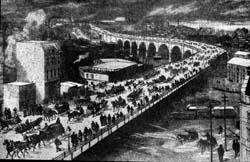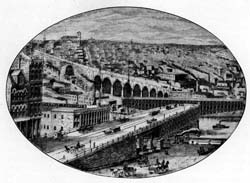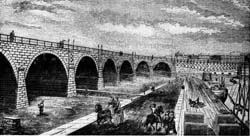|
Bridges of Cleveland and Cuyahoga County, 1918 THE OLD DETROIT-SUPERIOR VIADUCT By Henry W.S. Wood Tempestuous proceedings marked the birth of the old Superior-Detroit viaduct, which was opened to the public on December 28, 1878, after nearly a decade of bickering, injunction suits and futile efforts to block the improvement. The ease and equanimity with which the new Superior-Detroit high level bridge came into being was in marked contrast with the bitter warfare which lasted for years before the old viaduct was finally completed. IN 1836, Cleveland became a city by the granting of a charter from the legislature. Settlers west of the Cuyahoga River had formed another community and incorporated it under the name of the City of Ohio, more commonly called Ohio City. It was formerly Brooklyn Village. The crossings of the Cuyahoga River in the earlier days were made over bridges of crude construction, the earliest settlers crossing by means of ferries. Some old pioneers still well remember those early days. Then came a stringer bridge spanning the river, with a rope to steady the person making the passage. Finally between the present Center Street bridge and the old ferry landing which was at a point about opposite Superior Avenue, there was constructed a float bridge of large whitewood logs chained together. One spring there came a great flood and this float bridge was carried out into the lake. It was succeeded by a pontoon structure made of flat boats chained together. Another flood several years later also carried it into the lake. It was followed by a wooden structure which in due time shared the same fate.
THE OLD DETROIT-SUPERIOR VIADUCT A new bridge being an imperative necessity, efforts were made to have the two cities agree upon a plan a equally dividing the cost of construction between them. in 1836 a style of bridge was decided upon, the job let, and the structure was nearly completed. James S. Clark and John W. Willey at that time owned large tracts of land in what was then called Willeyville, located in the flats south of Columbus Street. They also owned considerable land on the north side of Columbus Street and were the men responsible for the construction of the original Columbus Street bridge. They boldly conceived the plan of endeavoring to divert traffic from Wooster and other points south across the Columbus Street bridge to the detriment of business men located in Ohio City. A part of their plan was to prevent the reconstruction of the Center Street bridge, so they secured a temporary injunction in the courts and for some time work was suspended. Residents of the west side were entirely willing to have the Columbus Street bridge in operation but they also wanted one at Center Street and
there came into being at that time the famous slogan, "Two bridges or none." The court injunction, standing in full power upon the Center Street bridge, made its completion impossible, so attention was directed to the matter of carrying out the threat of doing away with the Columbus Street bridge. The council of Ohio City passed an ordinance on May 26, 1836, ordering the cutting away of the south draw of the old Columbus Street bridge and on the night of May 27, 1836, the Ohio City marshal cut the hinges of the bridge and the south half fell into the river. There then took place what is unique in early Cleveland annals-the famous "bridge war," lasting during the month of June of that year. There were no casualties, eight were slightly wounded and a few rioters were taken to jail, but were soon bailed out. Their cases never came to trial. The result of the "bridge war" was that the west siders gained their point and two bridge were built, the Center Street bridge being completed after much discussion. In April, 1870, at an invitation from citizens on the east side of the river, J.F. Holloway was invited to lecture upon the subject, which he did in the East Side High School building, where the Citizens Trust Building now stands on Euclid Avenue near East 9th Street. He gave an elaborate description of plans for a high bridge, together with its estimated cost, and the amount of traffic then prevailing at different points across the Cuyahoga River. In 1871, the question of a high bridge was revived. It was asserted that without some enabling legislation, the city was without power to undertake the work. R.B. Dennis, a member of the house of representatives, during that year, drew up and introduced into the house, a bill authorizing the work. There was bitter opposition in Cleveland, the bridge opponents utilizing the Cleveland Herald as their organ. They assailed the measure in severest terms. The bill passed the house but failed in the senate. On April 18, 1871, there was introduced a resolution in the Cleveland city council providing for the appointment of a committee to examine and
OLD DRAWING SHOWING THE OLD VIADUCT FROM THE EAST END report on the best route and plans for improved communication between the two sides of the river. The city council after a long discussion adopted the resolution on May 8, 1871. During the summer of 1871, surveys were made of routes. One was planned to connect Ohio Street (now Central Avenue) on the east side, with Lorain Street on the west side. At a meeting of the city council on April 18, 1871, a petition was presented, asking that the necessary surveys, plans and estimates be made for a high level bridge "from high bank to high bank" with a double track carriage way, providing also for street car tracks and sidewalks. This petition was signed by M.A. Hanna, John H. Sargent, J.M. Coffinberry, F.W. Pelton and sixty-seven others. It was argued at a public meeting on the west side held April 22, 1871, that the number of passengers crossing the viaduct per day would be 15,240, and that the number of teams would be 4,671. It was stated, further, that
tolls received from foot passengers, street cars and vehicles at the rate of two cents each would ultimately pay for the investment and create a sinking fund so the viaduct would in all probability cost the city nothing. At this same meeting, a resolution was passed, approving the bill which had been introduced in the legislature by Mr. Dennis and its immediate passage was urged. The legislature in January, 1872, adopted the Dennis bill, which granted the right to build a viaduct. The Cleveland Herald assailed it with great bitterness. On January 30, 1872, a resolution was introduced in the city council of Cleveland proposing that the railroad tracks be built in connection with the new viaduct. This necessitated a change in the bill. Accordingly a revised bill was drawn and offered as a substitute. There were also introduced a bill to vacate a part of the Ohio Canal in the city of Cleveland. Both of these were strenuously opposed, chiefly by east siders. As an argument in favor of the bridge, it was stated by Judge Coffinberry that Cleveland twenty years before that date contained but 17,000 inhabitants, while in 1872, the population was approximately 100,000, with the city growing very fast. He recalled the time when the Lighthouse Street bridge was built after long litigation and predictions of bankruptcy, of ruinous conditions and dangers to navigation. On April 27, 1872, the bill authorizing the construction of the viaduct became a law and two days later, the bill permitting Cleveland to occupy a part of the Ohio Canal site was also adopted. The question as to whether toll should be collected for vehicles and pedestrians using the viaduct was also included in this bill, permission being given the electors to decide the matter by vote. Two routes were then proposed, the first from Superior Avenue, where it intersected Water Street, to the intersection of Pearl (West 25th Street) and Franklin Streets. The second route suggested was from the intersection of Superior and Union Streets to the intersection of Pearl (West 25th Street) and Detroit Streets. The second route was recommended by the council and finally approved.
OLD VIADUCT, FROM THE WEST SIDE, FROM A WOOD CUT On March 30, 1872, the committee recommended that the question be submitted to a vote of the people at the ensuing election in April. This resulted in a vote of 7,548 in favor of the bridge and 2,623 against, making a majority for the project of 4,925. The first estimate of the cost of the stone viaduct was $759,328.78. A protest against the construction of the bridge was filed January 28, 1873, being signed by Chas. A. Otis, H. Garretson, W.P. Southworth, Fayette Brown, D.P. Eels, Samuel Williamson and 252 others. They claimed the cost would be excessive and that a bridge to accommodate all the people could be constructed at much less expense. A similar remonstrance was filed February 11 of the same year and was referred to the board of improvements. On August 19, an ordinance authorizing the issue of bonds to the amount of $117,893, for land for the viaduct, came before the council. The resolution was lost by a vote of eleven to twelve. The following morning, the Cleveland Leader referred to the occurrence: "Thus the ordinance was consigned to its fate and the viaduct killed." Citizens of the west side were keenly aroused and held public indignation meetings, sending petitions of remonstrance to the council, signed by more than 4,000 voters.
Despite constant opposition, land was finally purchased October 7, 1873, E.W. Ensign of Buffalo was awarded the contract for the masonry construction for $512,720, his being the lowest bid. Initial plans contemplated a viaduct roadway fifty feet wide, but a change was proposed and adopted on March 16, 1875, making it sixty-four feet. The total cost of the project with these changes was $2,200,000, the cost of the bridge structure alone being about $1,6000,000. Even after the work was begun and $500,000 expended, resolutions were presented to the council asking that the entire project be abandoned. The board of improvements, however, reported adversely and the work went on. On December 21, 1875, the city council asked the legislature to authorize the collection of tolls upon the bridge when completed, tolls not to exceed three cents for a single team and five cents for a double team each way. This money was to go towards the expense of constructing the viaduct. On January 25, 1876, another resolution was presented, asking the legislature to permit toll to be collected "from each passenger and vehicle passing over the bridge, as it may be deemed necessary." To pay the increase cost of the viaduct, which resulted from change in plans, the question of voting additional bonds submitted to the people on May 4, 1876. That the viaduct had its firm friends was indicated by the fact that 6,863 voted in favor of bond issue, while only 3,181 opposed it. At a meeting held April 18, 1876, H.C. Ford, councilman representing the sixteenth ward, introduced the following resolution which was adopted: "That as a measure of equalization and relief from immediate burdensome taxation, it is the judgment of this council that for the first twenty
years after the completion of the Superior Street viaduct, a toll shall be required from all traffic passing over the structure." On December 5, 1876, N.A. Gilbert introduced a resolution calling the attention of the council to the action of the legislature authorizing the city to collect toll. Various ordinances were introduced and referred to committees before action was taken. At no time, however, was toll of any kind ever charged for passing across the viaduct. During the period from 1870 to the time of the bridge’s completion and opening on December 28, 1878, the agitation for and against the viaduct was constantly before the people. There were strong opposition from the east side of the river where claims were repeatedly made that taxes would be excessive due to its cost. Even west siders expressed opposition, maintaining that the completion of the bridge would mean trade would leave the west side and go to east side merchants. Injunctions and objections caused repeated changing of plans. The question of toll was brought in frequently to influence voters to support the bridge although there was evidently little intention on the part of those advocating tolls to make the new structure a toll bridge in any sense. The viaduct when completed, proved to be an imposing structure consisting of eight acres of 83-foot span, two arches of 971/2-foot span, together with refraining walls. The masonry work was 1,382 feet in length and 72 feet in height above the pile foundations, the latter being carried to a depth of twenty feet into a stratum of clay. Pile, timber and concrete grillage was used. East of the river span the iron work consisted of a continuous plate girder of three 50-foot spans, followed by two 145-foot spans and one 160-foot span. The pivot span crossing the river itself was 332 feet. The total length of the viaduct was 3,211 feet. It rose sixty-eight feet in height above the river. The old viaduct for forty years served its purpose in building up the city. Now it gives way to the splendid structure which more fully meets the needs of Cleveland’s growing industries and expanding population.
|
||
| NEXT CHAPTER | PREVIOUS CHAPTER | TABLE OF CONTENTS |
|
||



